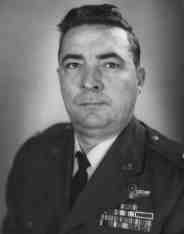
| FOUND! according to World News Daily, (2/12/15) the bomb has been found! |

Colonel Howard Richardson flew thirty-five B-17 bomber missions from Great Ashfield, England during World War II. He and his crew flew the "Mississippi Miss," not unlike the "Memphis Belle" which was popularized in a recent movie. Colonel Richardson stayed in the Army Air Corps (later the US Air Force) as a pilot and helped organize flight logistics for the Berlin Air Lift. Later, he flew planes carrying hydrogen bombs on practice runs in the U.S.
Colonel Richardson, remained
in the Air Force from WWII through the Korean War but seems to
prefer talking about his B-47 days. This is his favorite story:
I had a B-47 crew at Homestead AFB, Florida with the 19th Bomb
Wing. The wing was flying a USCM. We took off and headed out over
the Gulf and picked up an air refueling, flew further west then
turned north and went almost to Canada then east. Our bomb run
was made in the Northeast; then we turned south to head home.
This was in February and we were flying at around 38,000 feet.
Over the Carolinas we entered "friendly territory" (no
longer in simulated combat). I noticed about three or four F-86s
flying below but they soon disappeared. We were not supposed to
be working with any fighters at this time. All of a sudden we
felt an impact and a flash off my right wing which was the fighter
going down. I saw that the number six engine was no longer attached
at the rear and was hanging down. The wing tank had disappeared.
I later found out that an F-86H was making a run on the rear of my B-47 when his automatic release failed to work. The F-86 pilot looked up from his radar and saw my plane but too late. His wing shoved my aileron into my main spar and broke it. Some debris went back into my vertical and horizontal stabilizers and punctured my auxiliary fuel tank. I alerted the crew for possible ejection but told them to hold for now. We called the tower at Savannah and told them to tell SAC Headquarters.
We had a Mark 15 nuclear bomb on board. It was not, however, a complete bomb (the detonator was deliberately removed for safety). The Air Force Tactical Doctrine at that time said that the first priority in any incident was the safety of the crew. This doctrine was changed later after other incidents and releases. I used my own emergency procedure which was to descend to 20,000 feet and put gear and flaps down to see if I could control the aircraft at landing speed. The control was marginal so we elected to go offshore and release the weapon because if we crashed, it would come forward through the crew area like a bullet through a gun barrel. We called the tower and told them what we planned to do. We released the weapon offshore and descended to enter the traffic pattern. I had a big job, keeping the aircraft lined up with limited control. We touched down at a higher than normal speed, bounced and skipped. I pulled the brake chute and turned off the runway. We were safe, but the B-47 would never fly again — the main spar was broken. I had the crew write down every detail before we went to sleep. We got little sleep before we were awakened and told to brief General Power, who had flown up from Homestead to Savannah for the briefing. I guess everything went all right because he asked us to fly back to Homestead in his aircraft.
This incident was written up in the November 1990 issue of Air and Space Magazine. The following is quoted from that article by Curt Newport: "All the major players in the 1958 accident have long since retired from the military. Leland Woolard, the navigator of the B-47, died in 1986. Richardson, the bomber's pilot, seems to regret jettisoning the bomb, even though he did it to save his aircraft and crew. After receiving the Distinguished Flying Cross for his actions during the accident, he became a B-47 squadron commander, went on to fly B-52s, and now dabbles in real estate. Copilot Lagerstrom is today a flight captain for a major U.S. airline. He and Richardson never flew together again. Clarence Stewart, the F-86 pilot, was able to prove that his radar scope was defective. He later spent several years flying jets in Southeast Asia, where he was forced to eject from, an F-105 fighter after being hit by small-arms fire. He retired from the Air Force in 1977 and spends his time flying his two light aircraft. It's been more than 30 years since the incidents of that dark night in February, but for Clarence Stewart, Howard Richardson, and Robert Lagerstrom, the memory of what happened is still embedded as deeply in their memories as the hydrogen bomb is in the sea floor."
Editor's Note: The military has code words for mishaps that involve nuclear weapons. The most serious are those in which a weapon is lost or an area contaminated with radioactivity. They called them "Broken Arrow."
See the Broken
Arrow letter (Site7) for an epilogue. Read the rest of the story 2005. Click
the star
|
Visitors since
June 6, 2000 |